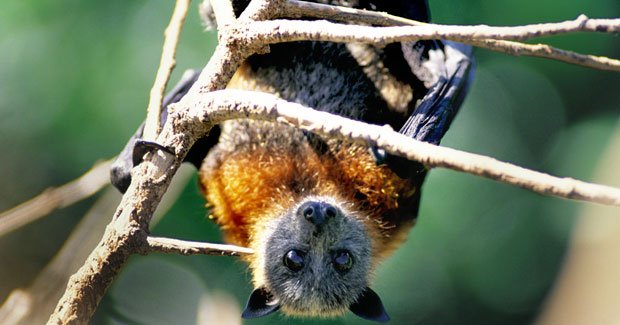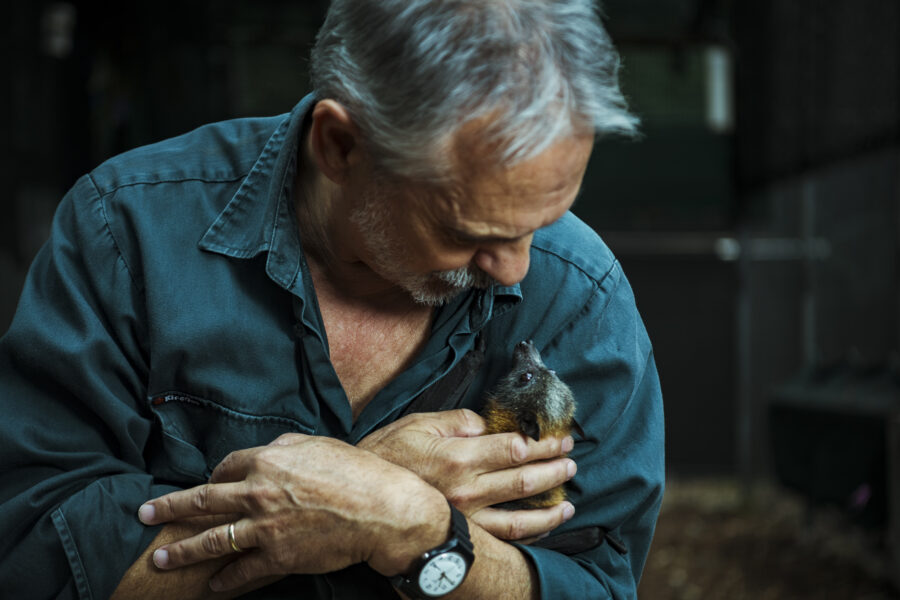Hanging with flying foxes

At the Belgry, Bellingen’s appropriately named youth hostel, a corridor is lined with photographs of naked backpackers enjoying the NSW north coast – in the rainforest, under waterfalls and on empty beaches. The shot of the feral princess from Melbourne draped in the diaphanous shed skin of a 3m carpet python is worthy of a fashion magazine, though it looks as if the outfit’s original owner could have swallowed her whole. Fortunately, carpet pythons generally go after smaller stuff: bush rats, the odd possum and flying-foxes.
If you happen to be crossing the Bellinger River at Lavender’s Bridge around dusk you could be forgiven for thinking that this is the flying-fox capital of the universe. The exodus of up to 80,000 of them from Bellingen Island Reserve, upstream from the bridge, is one of the country’s premiere wildlife spectaculars. They’re off for a night’s foraging at feeding grounds up to 30km away, where eucalypt, paperbark and other native blossoms provide a rocket fuel of raw nectar, which is necessary for long-range flight. As the animals feed, their fur and wings become dusted with pollen grains, which are transferred from tree to tree. The seeds of the rainforest fruits that supplement their diets – including figs, koda berries and brush cherries – are dropped over a wide area.
In this way flying-foxes connect forest remnants across large distances far more effectively than other mammals, or pollinating birds and insects. But as patches of native bush diminish in size and number throughout the animals’ range, their choice of places to feed and camp has been reduced. We know from early settlers’ accounts that they’ve been coming to Bellingen Island for at least 100 years, and Aboriginal tradition refers to their presence much earlier than that. They once had their pick of dozens of sites in this area, and until the 1970s the island was left unoccupied for up to 10 years at a time. Then the animals began using the site constantly. Despite this, the overall population is in decline, falling by as much as one-third since the late 1980s.
A track from the old caravan park descends to the silted-up river bed before climbing to the ‘island’; the Bellinger River abandoned its loop around the rainforest remnant decades ago. There’s a smell – a subtle blend of sweet basil, compost and bat pheromones. If you abandon your prejudices, it’s the kind of animal essence from which, you imagine, some free-thinking perfumer could conjure a beguiling scent. The trees are festooned with thousands of flying-foxes, like a bumper crop of leathery black fruit. A twig breaks under my foot and I’m suddenly in the spotlight of hundreds of pairs of snapping brown eyes. They have sharp, intelligent faces and foxy ears. It’s not hard to see why some scientists have thought they might be classified as primates.
Restlessness intensifies, and one or two animals take flight, the sound of their wings recalling the wheezy quality of a big old umbrella I once lost. The backward flip is the thing to watch out for. That’s when a suspended flying-fox switches its grip from its toes to its thumbs, reorientating itself head up, tail down. If you spot this manoeuvre, don’t hang around underneath because it probably means that something digested is about to land on your head.
Smitten by flying-foxes
Rainforest regenerator Kathryn Wood recalls her volunteer group’s end-of-year gathering held just before Christmas 1986. The regenerators, who wage war on Bellingen Island’s invasive weeds, had arranged to picnic among the flying-foxes. A day or so before there’d been a powerful storm and a couple of trees were down. On inspecting the damage, the regenerators found many dead and injured flying-foxes among the fallen branches of a white cedar tree. The most seriously injured animals were euthanised, but miraculously, seven young had survived.
Flying-fox littlies require round-the-clock care so Kathryn decided she’d put them all in a basket and take them to the bookshop where she worked. At the time, her co-worker was local naturalist and wildlife photographer Vivien Jones. The cuteness of baby flying-foxes cannot be overestimated and Viv was smitten. She adopted a young female she named Ingrid – “By far the prettiest of the bunch,” Viv insists. That was the start of it. Similar to Dian Fossey with her mountain gorillas, Viv Jones, the bat woman of Bellingen Island, had found her calling.
Throughout the 1980s and ’90s, nurturing a flying-fox was seen by the majority of fruit growers as on a par with giving succour to terrorists. In 2001, grey-headed flying-foxes were listed as vulnerable by the NSW, Victorian and Federal governments. Species numbers were rapidly declining due to habitat destruction and shooting. Sydney-based flying-fox specialist Dr Peggy Eby recalls being summoned to public meetings along the east coast to explain the vital ecological role of flying-foxes as rainforest pollinators and seeders.
“For many people, however, flying-foxes were no more than vermin,” Peggy says. “Reversing these negative attitudes seemed almost impossible.” Then at another encounter with the shoot-’em-up-and-run-’em-out-of-town brigade, Viv appeared with a portfolio of flying-fox photographs she’d taken of the Bellingen colony.
“Flying-foxes have been demonised for so long in Australia, but looking at Viv’s images, anyone can see that they’re extremely attractive and intelligent animals,” Peggy says. “People start to relate to them.”
Today, Viv has a catalogue of thousands of flying-fox photos that she supplies to newspapers, magazines and websites, even those with a negative view on the mammals. She hopes that familiarity with flying-fox faces will promote more thoughtful attention to the animals. She also works at providing the public with information from scientific research. Peggy describes her relationship with Viv as symbiotic. “In 1999, Viv began making a photographic record of the number of animals occupying selected trees on the island, photographing each site twice a week for two years,” Peggy says.
Viv’s close-ups of flying-fox faces convinced Peggy that it was possible to identify individuals and track their daily activity. Significant discoveries about flying-fox behaviour followed. Viv’s photos showed that individuals are territorial and defend their bit of tree space with threatening ‘shouts’ and a theatrical flashing of thumbs and teeth. Males are faithful to their patch month after month, year after year, dextrously scent-marking boundaries with secretions from glands in the back of the neck. Females have favoured roosts, too, but move from camp to camp more frequently, which connects them to a larger number of amorous males. They may even have male consorts in every camp they visit.
Noisy bat colony
The colony is at its noisiest from February to April, the height of the mating season, and most of the racket you hear is made by males shouting seductively into females’ faces. Many of the colony’s immediate human neighbours have learned to develop a tolerant attitude to their wild partying. Although not everyone in town is bat-happy, they’ve been accepted as part of the branding of Bellingen, alongside concert pianist and local celebrity David Helfgott, subject of the movie Shine.
During the day the island resembles a dormitory. Some flying-foxes doze, heads tucked into furled wings. Others are awake, grooming themselves, caring for babies, mating, looking about, squabbling with neighbours or just fanning their wings in an effort to shrug off the thick humidity. By late September, after a six-month gestation, females begin giving birth (see “Hard labour”, page 109). Hanging in a tree seems a precarious way to go about it, but the mother’s wings form a safety net in case her baby doesn’t immediately grasp a nipple with its teeth and find a firm toe-hold in her belly fur. For the ensuing five weeks the littlie accompanies its mother everywhere.
“During the colony’s nightly exodus, you can see the torpedo-like shapes of hundreds of youngsters, each clinging to its mother’s side as she flies,” Viv says. “I call them jockeys, because that’s exactly what they look like.”
The camp’s size is in a constant state of flux. Last November new arrivals spilled into nearby trees. Many of the newcomers were mothers with developing young. A week of heavy rain followed by a weekend of high winds buffeted the camp. Two days later the skies had cleared and the forest floor was littered with the emaciated, dead bodies of dozens of young flying-foxes. Viv thinks they may have starved to death, the downpour washing nectar from the blossoms of their food trees. Local WIRES volunteer Sally Neale arrived to take charge of a survivor, a young female.
“It was a far worse scenario in 2004,” Sally says. “Back then, more than 5000 flying-foxes died of heat stress when the temperature remained above 30°C for several days and peaked at 45°C.”
Sally carefully persuaded the dehydrated young female – which she named Elizabeth – to take some fluid from a syringe. The flying-fox spent approximately three months in Sally’s backyard atrium before being introduced to a communal crèche with other young bats for six weeks and then released into the Bellingen camp.
Young flying-foxes gather
By early January, the camp’s adult population has swollen further. Downstream on the banks of the Bellinger River, onlookers enjoy the spectacular supper show. As the sky slides from blue to orange to salmon pink, a trickle of flying-foxes becomes a flood. After following the river for a short distance, great trails of flying-foxes head west and are lost to the huge expanse of state forest bordering Bellingen. Somewhere out there a massive flowering of nectar-rich blackbutt is taking place.
As the last of the adults leave the roost for the night, I enter the camp with Viv. Far from being silent and deserted, it’s filled with a chirruping clamour of thousands of young flying-foxes. Their mothers began leaving them alone here when they were five weeks old. To begin with, they climbed nimbly around among the branches using their feet and thumbs, flapping their wings purposefully. In the weeks since, those flight muscles have strengthened. Tonight it seems the metamorphosis of Viv’s little jockeys is nearing completion.
The treacly night air is stirred by scores of little helicopters – Viv’s description of young flying-foxes furiously beating their wings. The bodies sway from side to side as they look around. Then one will give a quick flap, let go of the branch and become briefly airborne. By now most of them can fly only as far as the trees at the edge of the camp. It will be another two months before they’ll fly well enough to forage for themselves. Until then, they’ll continue to rely on their mothers’ milk.
The adults return to the camp just before dawn, their fur dusted with fragments of blossoms and pollen – the forest’s real pixie dust. Scattering it far and wide, flying-foxes have been working real magic overnight – the kind that has kept Australian forests in business for millions of years. Hereabouts it’s said that the spell will hold for as long as there are flying-foxes on Bellingen Island.


